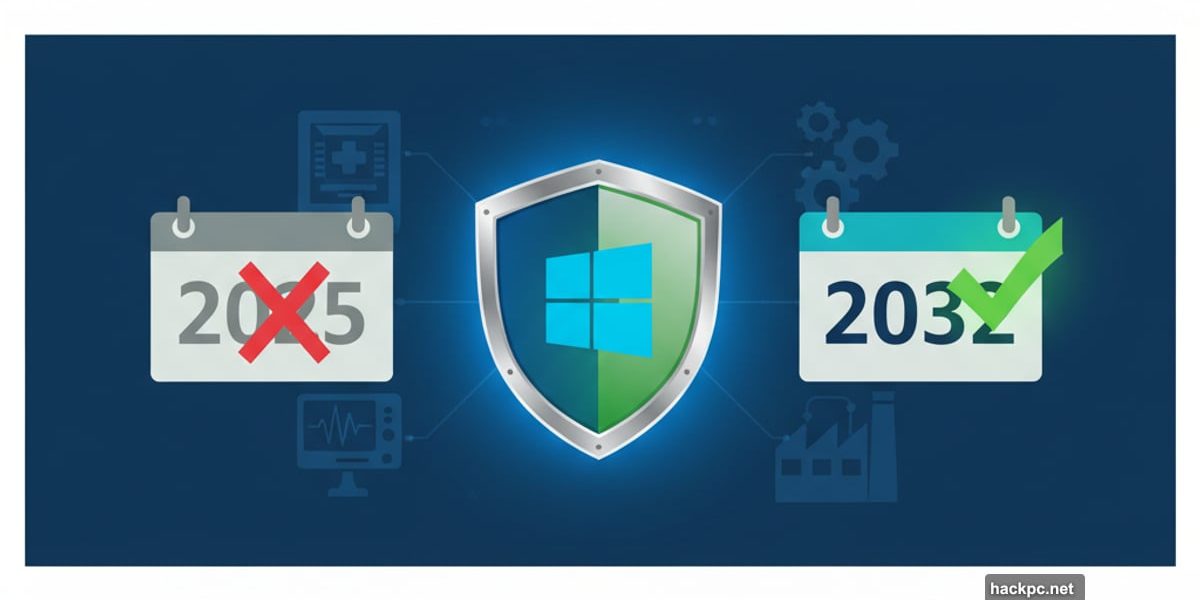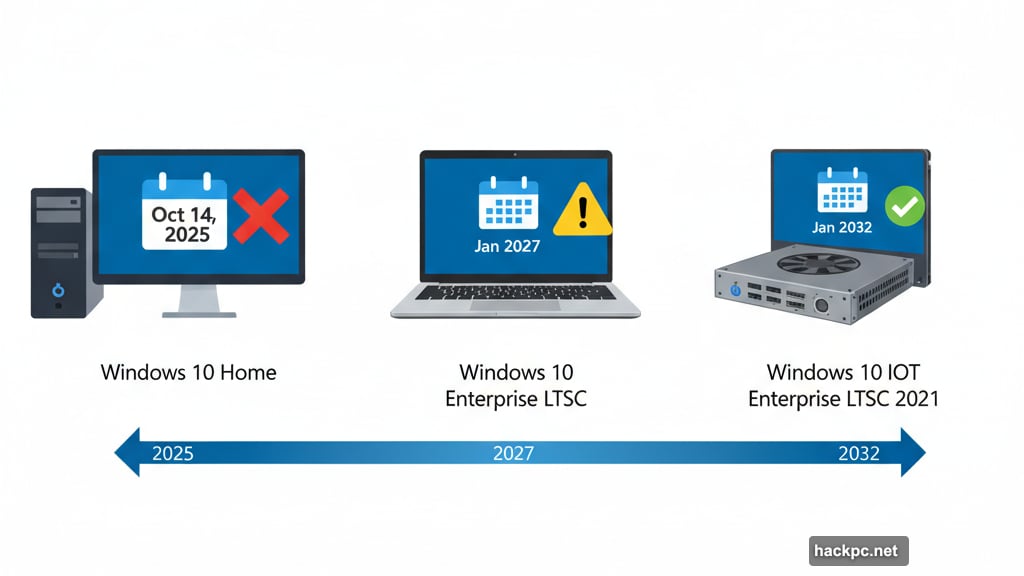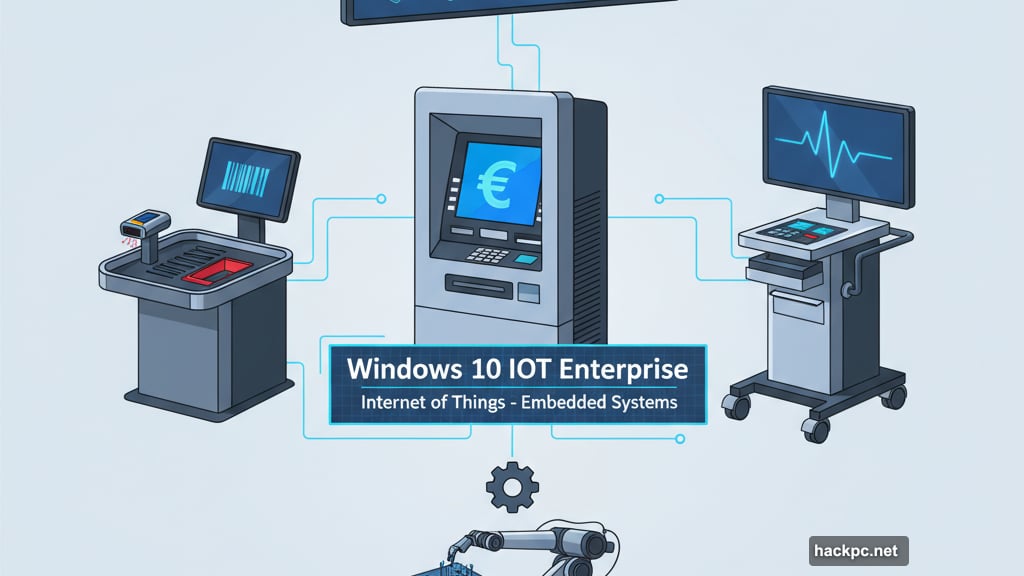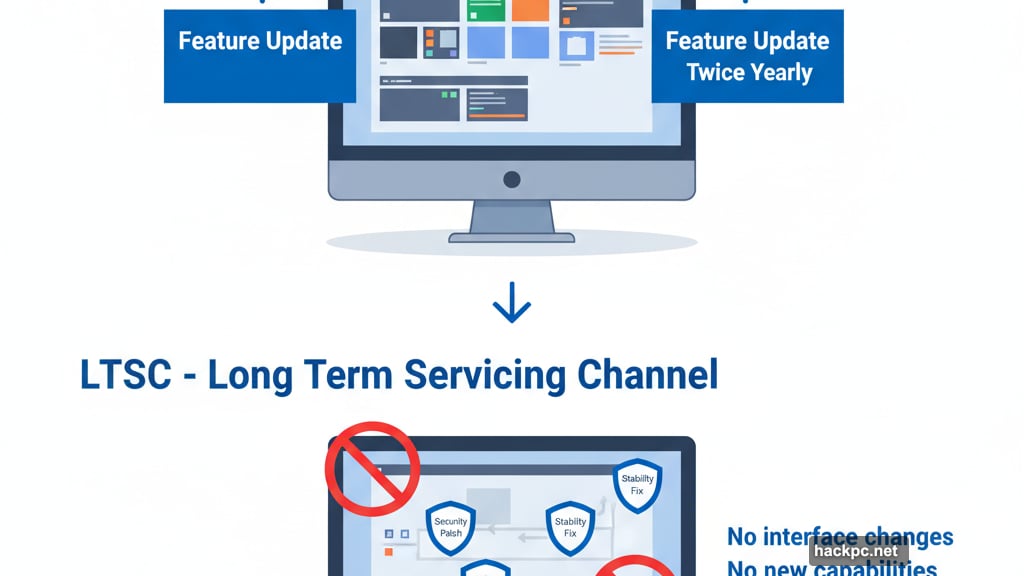
Windows 10 officially died on October 14, 2025. Right?
Not quite. One version keeps running until January 2032. That’s seven more years of security updates while everyone else scrambles to upgrade.
It’s called Windows 10 IoT Enterprise LTSC 2021. The name sounds like alphabet soup, but this specialized version serves a crucial purpose. Let’s break down what makes it different and whether you can use it.
IoT Means Embedded Devices, Not Regular PCs
IoT stands for “Internet of Things.” That’s the industry term for computers hidden inside other machines.
Think ATMs. Self-checkout kiosks. Medical devices. Factory robots. Digital signs. These devices run specialized computers with locked-down operating systems.
Windows 10 IoT Enterprise powers millions of these embedded systems worldwide. Unlike your home PC, these machines can’t tolerate frequent updates or changing features. An ATM needs to work exactly the same way for years without surprises.
That’s where Microsoft’s IoT versions come in. They’re stripped-down, security-focused variants of Windows designed for fixed-purpose devices. You won’t find them on consumer laptops or desktops.
LTSC Extends Support for Mission-Critical Systems
LTSC means “Long Term Servicing Channel.” It’s Microsoft’s way of saying “this version stays stable forever.”
Regular Windows 10 got feature updates twice a year. New menus, changed settings, added capabilities. That constant evolution makes sense for home users who want the latest features.

But imagine a hospital medical device that gets a surprise interface update. Or a retail system that suddenly changes how transactions work. Disaster.
LTSC versions skip feature updates entirely. They only receive security patches and stability fixes. No new capabilities. No interface changes. Just protection against threats.
The support timeline tells the whole story. Standard Windows 10 ended October 14, 2025. Windows 10 Enterprise LTSC runs until January 2027. But Windows 10 IoT Enterprise LTSC? That one lasts until January 2032.
Microsoft Changed the Rules in 2021
This wasn’t always the plan. Windows 10 IoT Enterprise originally faced the same October 2025 deadline as other versions.
Then Microsoft released the 21H2 update in November 2021. That update extended IoT Enterprise LTSC support by seven years while leaving other versions unchanged.
Why the special treatment? Embedded devices live in hard-to-reach places. Some sit inside industrial machinery. Others mount on walls or poles. Physically accessing them costs serious money and time.
Plus, many IoT devices require certifications and approvals. Medical equipment goes through years of regulatory testing. Changing the software means repeating that entire process. So stability matters more than features.
Microsoft recognized these realities and extended support accordingly. Companies using IoT Enterprise LTSC can keep their devices running without expensive hardware replacements or risky software transitions.
Getting LTSC Requires a Special License
You can’t just upgrade to Windows 10 IoT Enterprise LTSC from regular Windows 10. It’s a completely separate edition that requires its own license.
Most organizations get these licenses through their original equipment manufacturers. If you buy an ATM or kiosk, it comes with the appropriate Windows license already installed.

For existing deployments, switching to LTSC means purchasing new licenses through volume licensing agreements. Your IT department handles this process. Individual consumers can’t easily buy these licenses.
That complexity makes sense given the long-term commitment. Microsoft supports this version for over a decade. They need to verify you’re using it for appropriate purposes.
Also, you can’t upgrade in place from standard Windows 10 IoT Enterprise to the LTSC version. You need a clean installation with the proper license key from the start.
Should Regular Users Switch? Absolutely Not
Some tech-savvy users see that 2032 date and wonder if they can skip the Windows 11 upgrade. Bad idea.
Windows 10 IoT Enterprise LTSC has serious limitations. No feature updates ever. No Microsoft Store access. Many apps won’t work correctly or at all.
Web browsers will eventually struggle with new standards and protocols. Hardware manufacturers will stop writing drivers for it. Games and creative software will drop support.
Plus, getting the license for personal use involves complicated workarounds that Microsoft doesn’t officially support. You could lose access to your system during activation checks.
For businesses, the risks multiply. Compliance requirements change over time. Security standards evolve. An operating system frozen in 2021 won’t meet 2030 requirements.
If your embedded device absolutely must run Windows 10 for the next seven years? Then LTSC makes perfect sense. But for regular computing, it’s the wrong tool for the job.
Better Options for Most Users

Regular desktop and laptop users have three sensible paths forward.
First, upgrade to Windows 11. It’s the straightforward option that gives you full support, new features, and long-term viability. Most PCs from 2018 or newer can run it just fine.
Second, stick with Windows 10 Enterprise LTSC if you’re a business user. It runs until 2027 without the severe restrictions of the IoT version. Still not ideal, but better than IoT Enterprise for general computing.
Third, purchase Extended Security Updates. Microsoft offers three more years of Windows 10 support for a fee. It’s not cheap, but it buys time if you absolutely can’t upgrade yet.
For embedded devices that truly need Windows 10 long-term? Windows 10 IoT Enterprise LTSC delivers exactly what you need. But consider whether Windows 11 IoT Enterprise LTSC makes more sense. It has mainstream support until 2029 and extended support until October 2034.
That’s even longer than Windows 10 IoT Enterprise LTSC. Plus, you get newer features, better hardware support, and more modern security standards.
Know Your Windows Version Before Deciding
Windows 10 didn’t actually end for everyone on October 14, 2025. But that nuance only matters if you’re running specific embedded systems.
Most users should treat October 2025 as the real deadline and plan accordingly. The IoT Enterprise LTSC extension exists for specialized use cases, not as a general escape hatch.
Take time to understand what version you’re running. If it’s standard Windows 10 Home or Pro, the deadline passed. Make a plan to upgrade or pay for extended support.
If you manage embedded devices on Windows 10 IoT Enterprise, verify whether you’re on the LTSC version. If not, consider switching now or evaluating Windows 11 IoT Enterprise for even longer support.
Either way, don’t panic. Understand your options, assess your needs, and make the right choice for your situation.



Comments (0)